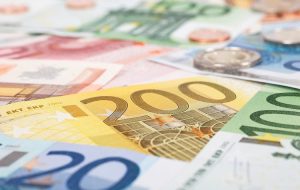Euro appears bid and gyrates around the 1.0600 region
Share: The Euro clings to daily gains vs. the US Dollar. Stocks in Europe extend the multi-day decline on Monday. EUR/USD keeps hovering around the 1.0600 zone. The USD Index (DXY) comes under pressure and disputes 106.00. Eurozone flash Consumer Confidence is due in the domestic docket. The Chicago Fed National Activity Index ticks higher in September.

- The Euro clings to daily gains vs. the US Dollar.
- Stocks in Europe extend the multi-day decline on Monday.
- EUR/USD keeps hovering around the 1.0600 zone.
- The USD Index (DXY) comes under pressure and disputes 106.00.
- Eurozone flash Consumer Confidence is due in the domestic docket.
- The Chicago Fed National Activity Index ticks higher in September.
The Euro (EUR) is extending its constructive price action against the US Dollar (USD), encouraging EUR/USD to once again break above the 1.0600 hurdle at the beginning of the week.
The Greenback, by contrast, extends the bearish move and challenges the 106.00 support when tracked by the USD Index (DXY) in a context of further improvement in the appetite for the risk complex and the resumption of the uptrend in US yields across different maturities.
In terms of monetary policy, market participants expect the Federal Reserve (Fed) to maintain its current stance of keeping interest rates unchanged at the November 1 meeting. This view was reinforced by comments from Fed Chair Jerome Powell at his appearance at the Economic Club of New York last Thursday.
At the same time, investors are contemplating the possibility of the European Central Bank (ECB) discontinuing certain policy measures. This comes despite inflation levels surpassing the bank’s target and growing concerns about the risk of a slowdown or stagflation in the Eurozone’s economy.
On another front, the speculative community increased their net longs in the EUR for the first time since mid-August despite unchanged expectations around a most-likely pause of the ECB’s tightening campaign that could extend until Q3 2024.
In the euro docket, the European Commission (EC) will publish its advanced gauge of the Consumer Confidence for the euro area for October.
In the US data space, the Chicago Fed National Activity Index improved to 0.02 for September.
Daily digest market movers: Euro appears limited above 1.0600
- The EUR extends the bounce against the USD on Monday.
- US and German yields resume the upside bias.
- Investors see the Fed keeping its interest rate unchanged in November.
- Market expectations suggest that the ECB will also keep rates unchanged.
- ECB is likely to encounter a stalemate in its interest rate hiking cycle.
- Geopolitical concerns in the Middle East remain in the centre stage.
Technical Analysis: Euro faces some consolidation near term
The EUR/USD keeps the consolidative mood well in place below the 1.0600 region at the beginning of the week.
If the bullish trend continues, EUR/USD may test the October 12 high of 1.0639, before moving on to the September 20 top of 1.0736 and the critical 200-day Simple Moving Average (SMA) of 1.0816. A break above this level might indicate a push to the August 30 peak of 1.0945, ahead of the psychological threshold of 1.1000. Any more advances might reintroduce a challenge of the August 10 high of 1.1064 before reaching the July 27 top of 1.1149 and potentially the 2023 peak of 1.1275 seen on July 18.
If the selling tendency returns, there is an immediate support at the low of 1.0495 from October 13 prior to the 2023 low of 1.0448 seen on October 3, all before the round level of 1.0400. If this zone is violated, the weekly lows of 1.0290 (November 30, 2022) and 1.0222 (November 21, 2022) may be retested.
It is crucial to recall that the risk of sustained negative pressure persists as long as the EUR/USD remains below the 200-day SMA.
(This story was corrected on October 23 at 08:20 GMT to say that the 1.0222 level was reached on November 21, 2022, not November 30, 2022.)
Euro FAQs
The Euro is the currency for the 20 European Union countries that belong to the Eurozone. It is the second most heavily traded currency in the world behind the US Dollar. In 2022, it accounted for 31% of all foreign exchange transactions, with an average daily turnover of over $2.2 trillion a day.
EUR/USD is the most heavily traded currency pair in the world, accounting for an estimated 30% off all transactions, followed by EUR/JPY (4%), EUR/GBP (3%) and EUR/AUD (2%).
The European Central Bank (ECB) in Frankfurt, Germany, is the reserve bank for the Eurozone. The ECB sets interest rates and manages monetary policy.
The ECB’s primary mandate is to maintain price stability, which means either controlling inflation or stimulating growth. Its primary tool is the raising or lowering of interest rates. Relatively high interest rates – or the expectation of higher rates – will usually benefit the Euro and vice versa.
The ECB Governing Council makes monetary policy decisions at meetings held eight times a year. Decisions are made by heads of the Eurozone national banks and six permanent members, including the President of the ECB, Christine Lagarde.
Eurozone inflation data, measured by the Harmonized Index of Consumer Prices (HICP), is an important econometric for the Euro. If inflation rises more than expected, especially if above the ECB’s 2% target, it obliges the ECB to raise interest rates to bring it back under control.
Relatively high interest rates compared to its counterparts will usually benefit the Euro, as it makes the region more attractive as a place for global investors to park their money.
Data releases gauge the health of the economy and can impact on the Euro. Indicators such as GDP, Manufacturing and Services PMIs, employment, and consumer sentiment surveys can all influence the direction of the single currency.
A strong economy is good for the Euro. Not only does it attract more foreign investment but it may encourage the ECB to put up interest rates, which will directly strengthen the Euro. Otherwise, if economic data is weak, the Euro is likely to fall.
Economic data for the four largest economies in the euro area (Germany, France, Italy and Spain) are especially significant, as they account for 75% of the Eurozone’s economy.
Another significant data release for the Euro is the Trade Balance. This indicator measures the difference between what a country earns from its exports and what it spends on imports over a given period.
If a country produces highly sought after exports then its currency will gain in value purely from the extra demand created from foreign buyers seeking to purchase these goods. Therefore, a positive net Trade Balance strengthens a currency and vice versa for a negative balance.
 آموزش مجازی مدیریت عالی حرفه ای کسب و کار Post DBA آموزش مجازی مدیریت عالی حرفه ای کسب و کار Post DBA+ مدرک معتبر قابل ترجمه رسمی با مهر دادگستری و وزارت امور خارجه |  آموزش مجازی مدیریت عالی و حرفه ای کسب و کار DBA آموزش مجازی مدیریت عالی و حرفه ای کسب و کار DBA+ مدرک معتبر قابل ترجمه رسمی با مهر دادگستری و وزارت امور خارجه |  آموزش مجازی مدیریت کسب و کار MBA آموزش مجازی مدیریت کسب و کار MBA+ مدرک معتبر قابل ترجمه رسمی با مهر دادگستری و وزارت امور خارجه |
 مدیریت حرفه ای کافی شاپ |  حقوقدان خبره |  سرآشپز حرفه ای |
 آموزش مجازی تعمیرات موبایل آموزش مجازی تعمیرات موبایل |  آموزش مجازی ICDL مهارت های رایانه کار درجه یک و دو |  آموزش مجازی کارشناس معاملات املاک_ مشاور املاک آموزش مجازی کارشناس معاملات املاک_ مشاور املاک |
- نظرات ارسال شده توسط شما، پس از تایید توسط مدیران سایت منتشر خواهد شد.
- نظراتی که حاوی تهمت یا افترا باشد منتشر نخواهد شد.
- نظراتی که به غیر از زبان فارسی یا غیر مرتبط با خبر باشد منتشر نخواهد شد.





ارسال نظر شما
مجموع نظرات : 0 در انتظار بررسی : 0 انتشار یافته : ۰